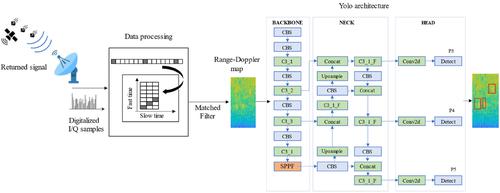当前位置:
X-MOL 学术
›
IET Radar Sonar Navig.
›
论文详情
Our official English website, www.x-mol.net, welcomes your feedback! (Note: you will need to create a separate account there.)
Deep learning-based space debris detection for space situational awareness: A feasibility study applied to the radar processing
IET Radar Sonar and Navigation ( IF 1.7 ) Pub Date : 2024-03-06 , DOI: 10.1049/rsn2.12547 Federica Massimi 1 , Pasquale Ferrara 2 , Roberto Petrucci 3 , Francesco Benedetto 1
IET Radar Sonar and Navigation ( IF 1.7 ) Pub Date : 2024-03-06 , DOI: 10.1049/rsn2.12547 Federica Massimi 1 , Pasquale Ferrara 2 , Roberto Petrucci 3 , Francesco Benedetto 1
Affiliation

|
The increasing number of space objects (SO), debris, and constellation of satellites in Low Earth Orbit poses a significant threat to the sustainability and safety of space operations, which must be carefully and efficiently addressed to avoid mutual collisions. The space situational awareness is currently addressed by an ensemble of radar and radio-telescopes that detect and track SO. However, a large part of space debris is composed of very small and tiny metallic objects, very difficult to detect. The authors demonstrate the benefits of using deep learning (DL) architectures for small space object detection by radar observations. TIRA radio telescope has been simulated to generate range-Doppler maps, then used as inputs for object detection exploiting You-Only-Look-Once (YOLO) frameworks. The results demonstrate that the object detection by using YOLO algorithms outperform conventional target detection approaches, thus indicating the potential benefits of using DL techniques for space surveillance applications.
中文翻译:

基于深度学习的空间碎片检测用于空间态势感知:应用于雷达处理的可行性研究
近地轨道上的空间物体(SO)、碎片和卫星群数量不断增加,对太空运行的可持续性和安全性构成了重大威胁,必须认真有效地解决这一问题,以避免相互碰撞。目前,太空态势感知是通过探测和跟踪太空态势感知的雷达和射电望远镜组合来解决的。然而,很大一部分空间碎片是由非常小和微小的金属物体组成,非常难以探测。作者展示了使用深度学习 (DL) 架构通过雷达观测进行小空间物体检测的好处。 TIRA 射电望远镜经过模拟可生成距离多普勒图,然后用作利用 You-Only-Look-Once (YOLO) 框架进行物体检测的输入。结果表明,使用 YOLO 算法进行的目标检测优于传统的目标检测方法,从而表明使用 DL 技术在空间监视应用中的潜在优势。
更新日期:2024-03-06
中文翻译:

基于深度学习的空间碎片检测用于空间态势感知:应用于雷达处理的可行性研究
近地轨道上的空间物体(SO)、碎片和卫星群数量不断增加,对太空运行的可持续性和安全性构成了重大威胁,必须认真有效地解决这一问题,以避免相互碰撞。目前,太空态势感知是通过探测和跟踪太空态势感知的雷达和射电望远镜组合来解决的。然而,很大一部分空间碎片是由非常小和微小的金属物体组成,非常难以探测。作者展示了使用深度学习 (DL) 架构通过雷达观测进行小空间物体检测的好处。 TIRA 射电望远镜经过模拟可生成距离多普勒图,然后用作利用 You-Only-Look-Once (YOLO) 框架进行物体检测的输入。结果表明,使用 YOLO 算法进行的目标检测优于传统的目标检测方法,从而表明使用 DL 技术在空间监视应用中的潜在优势。



























 京公网安备 11010802027423号
京公网安备 11010802027423号